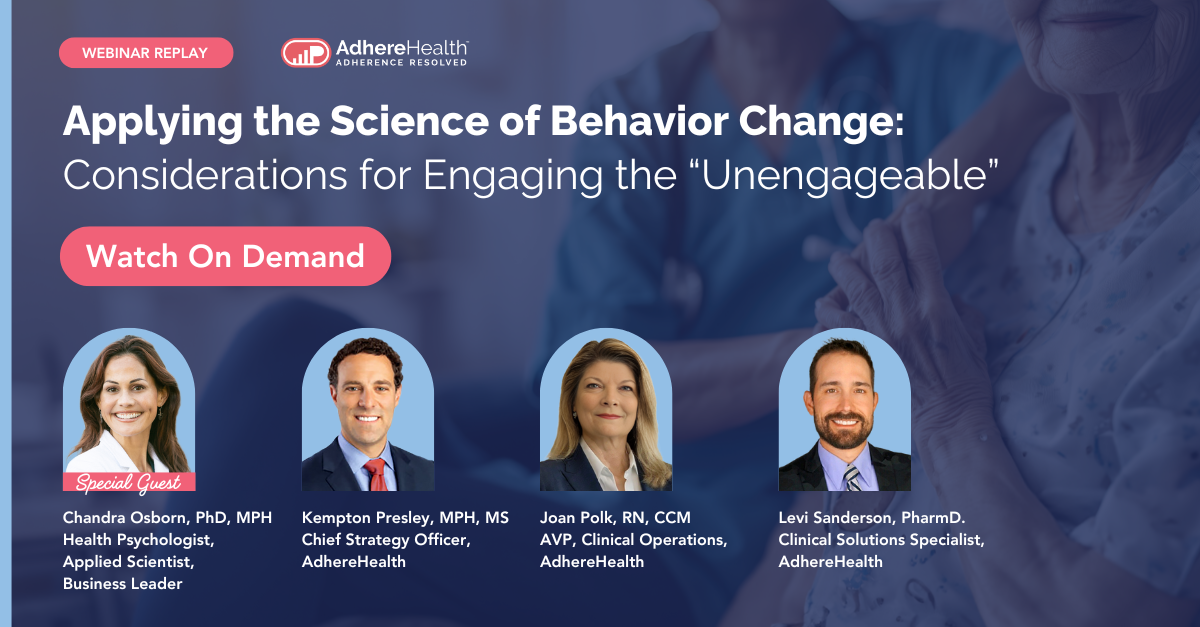Published on .
On September 12, 2024, AdhereHealth hosted an insightful webinar, “Applying the Science of Behavior Change: Considerations for Engaging the ‘Unengageable.'” The session delved into strategies for overcoming common barriers in healthcare member engagement, particularly for those deemed unengageable. This post highlights the key takeaways, the science behind behavior change and examples of successful member interventions.
Defining the “Unengageable”
The term “unengageable” refers to individuals who, despite healthcare providers’ repeated attempts, remain resistant to interventions that could improve their health. These members often face a complex mix of social, behavioral and psychological factors that hinder their willingness or ability to participate in recommended care. They may miss appointments, fail to adhere to medication regimens or have low health literacy. However, labeling members as unengageable oversimplifies the problem. The webinar stressed that these individuals can be reached—if approached with the right blend of science and empathy.
To read more about solutions for engaging the hardest-to-reach members, download our white paper: Three Steps for Engaging Your Highest-Risk, “Unengageable” MA Plan Members: Improve Medication Adherence and Star Ratings Performance with a Behavior Science–Based Approach
The Science Behind Behavior Change
To understand how to engage these individuals, the AdhereHealth team introduced two key models that underpin effective behavior change strategies: the Information-Motivation-Behavioral Skills (IMB) model and the Socioecological Model of Healthcare Utilization.
The IMB Model focuses on three core components:
- Information: Ensuring individuals understand what is required for better health.
- Motivation: Aligning health goals with personal values, social norms, and attitudes.
- Behavioral Skills: Empowering individuals with the tools and skills needed to take action.
By addressing gaps in these areas, healthcare providers can improve engagement, creating a path for sustainable health behavior change.
The Socioecological Model of Healthcare Utilization emphasizes that behavior is influenced by multiple layers of factors, from individual beliefs to broader social determinants of health (SDOH), such as access to transportation, financial stability and social support. To engage difficult-to-engage members, interventions must account for these external factors, alongside personal behaviors.
The AdhereHealth Approach to Member Engagement and Behavior Change
AdhereHealth takes a comprehensive approach, blending data analytics with behavioral science to identify at-risk members and tailor interventions. Their technology-driven platform uses predictive analytics to anticipate which members are at risk of disengagement, while their clinical outreach teams provide personalized, compassionate care.
By employing the IMB model and addressing SDOH through the socioecological lens, AdhereHealth has developed a playbook for engaging even the most reluctant members. Their approach includes:
- Proactive, multi-modal communication techniques: Reaching out to members through channels they prefer.
- Culturally competent care: Understanding and respecting members’ backgrounds to build trust.
- Collaboration with providers: Creating seamless care coordination that reduces member confusion.
- Addressing SDOH: Providing solutions to transportation, financial or social barriers that may prevent care access.
Real-Life Success Stories: Mr. Jones and Mrs. Smith
During the webinar, two powerful case studies were highlighted, demonstrating how engagement solutions rooted in evidence-based science can turn around seemingly impossible cases.
- Mr. Jones: An elderly man with uncontrolled health conditions due to lapsed medication refills. His health had deteriorated due to the passing of his wife of 50 years, who had been his caregiver. After engaging with AdhereHealth, Mr. Jones was set up with mail order to keep up with his refills and received assistance for both meal and grocery delivery. He was also given care instructions for how to take his pills, as well as information about local grief support groups.
- Mrs. Smith: An elderly woman who was considered noncompliant with her blood pressure medication regimen. The AdhereHealth team discovered she was the sole caregiver of her husband, who had dementia, and she was so overwhelmed with his care that she was forgetting to take her own medication. The Adhere Care Navigator helped her set up a daily routine to stay organized with her medication, plus started mail order to help with fills. In addition, they connected her with information about a caregiver support group for social connection to other people with similar experiences.
In conclusion
The AdhereHealth webinar underscored the importance of understanding both individual and social context when attempting to engage an “unengageable” member. Success is not just a result of more communication, but instead about tailored communication and engagement techniques that meet members where they are, both physically and emotionally. By applying the science of behavior change and addressing external barriers like SDOH, even the most disengaged members can achieve better health outcomes. AdhereHealth’s holistic approach proves that with the right tools and strategies, no member is truly unengageable.
Want to learn more about this webinar topic? Check out the on-demand replay: Applying the Science of Behavior Change: Considerations for Engaging the “Unengageable”



